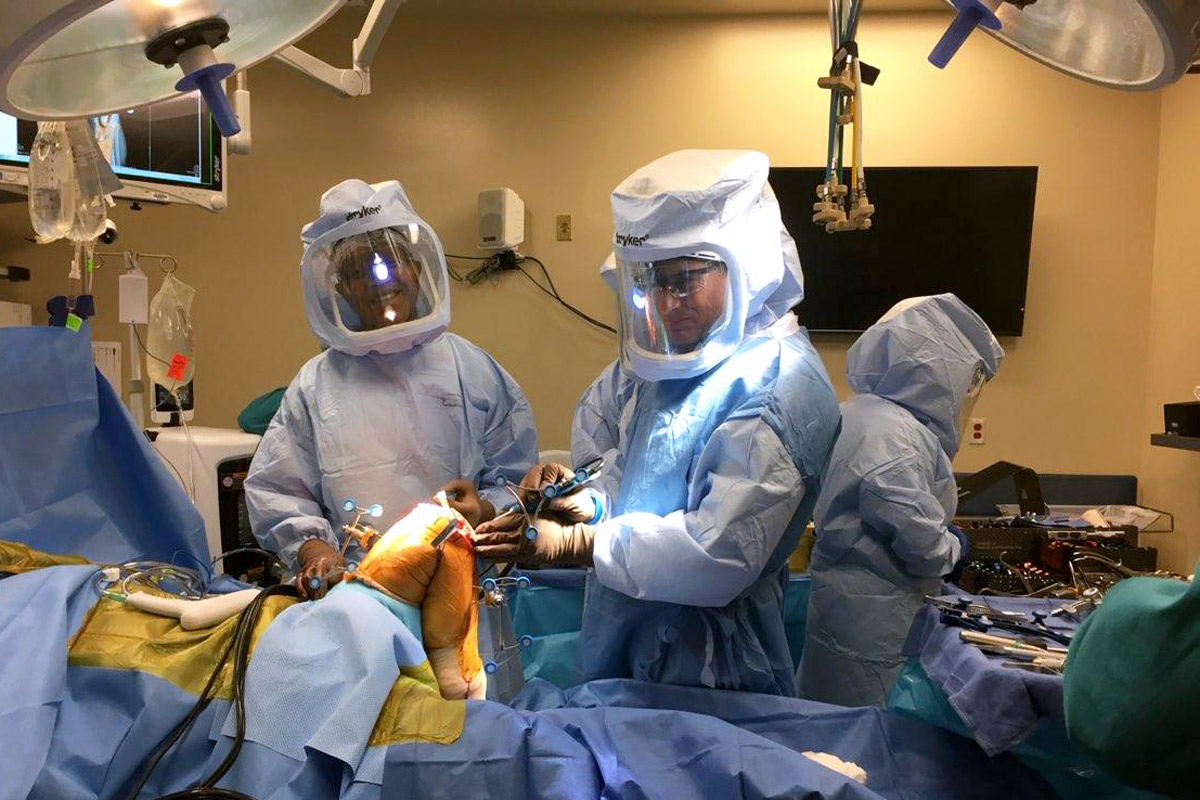
Kauai Surgeon Introduces Robotic-Assisted Total Knee Replacement to UCLA
Dr. Erik Zeegen, chief of joint replacement surgery at UCLA Medical Center, was interested in purchasing a robot in order to improve accuracy and precision for total knee replacement.
He also wanted to learn more about a novel type of total knee replacement that spares both the ACL (anterior cruciate ligament) and PCL (posterior cruciate ligament) for his active patients.
Aware of his options, Zeegen reached out across the Pacific to Dr. David Rovinsky, an orthopedic surgeon at Wilcox Medical Center on Kauai.
On Jan. 11, 2018, Rovinsky traveled to Los Angeles where he presented lectures on robotic-assisted total knee replacement and bicruciate sparing total knee replacement.
While there, he also conducted a lab in which Zeegen and his residents could perform robotic-assisted total knee replacement surgery on cadavers.
 A clinical assistant professor at the University of Hawaii at Manoa, Rovinsky has been involved in the development of a robotic system for partial and total knee replacement for the last two years.
A clinical assistant professor at the University of Hawaii at Manoa, Rovinsky has been involved in the development of a robotic system for partial and total knee replacement for the last two years.
He also has worked for the past eight years in the design and development of a high-performance total knee replacement.
“My involvement in total joint development and technology is deeply personal,” Rovinsky says. “I’m a 50-year-old surfer with arthritic hips and knees, looking at total joint replacements in my future. When I surveyed the available implants and technology, there was nothing yet available that I would want for myself or for my patients.”
According to Rovinsky, traditional total knee replacement requires the sacrifice of the ACL, and some designs sacrifice the PCL as well.
“It seemed odd to me that I would spend Fridays doing ACL reconstructions and Mondays removing healthy ACLs when I did total knee replacements,” he says. “So, I worked to assist in the development of a new type of knee replacement that preserves all of the knee ligaments and functions as a true knee resurfacing.”
Rovinsky explains that “resurfacing” means placing an artificial cap over the damaged bone without disrupting other healthy tissue. This gives patients a knee that has the desired combination of range of motion and stability for optimum function and return to high-level activities such as surfing and skiing.
In addition, the use of a robot enables Rovinsky and fellow Wilcox Bone & Joint Center orthopedic surgeons Drs. Derek Johnson and Daniel Judd to perform less-invasive surgery and achieve precision balancing of all four knee ligaments so that patients have a faster recovery.
“With robotic-assisted surgery, we can now do knee replacement surgery with accuracy and precision within 1 millimeter, or 1 degree of accuracy,” says Rovinsky, who in 2017 performed the first robotic-assisted total knee resurfacing on the West Coast.
“Our Wilcox Bone & Joint Center includes orthopedic surgeons who are highly respected in their field and have experience in some of the most advanced procedures in their profession,” says Jen H. Chahanovich, president and CEO of Wilcox Medical Center, and CEO of Kauai Medical Clinic. “At Wilcox, we are able to offer patients the unique combination of high tech and high touch care. We are proud to offer this level of expert care here on Kauai.”
Wilcox Medical Center has been a leader in technology for orthopedic surgery for more than 10 years with many firsts, including being the only medical center in Hawaii to offer total knee resurfacing and the first medical center in Hawaii to perform a robotic-assisted total knee replacement.
“My goal is to help spread the word and let the people of Hawaii know all the exciting and leading-edge technology available right here on Kauai,” Rovinsky says. “We host a Visiting Surgeons Program at Wilcox, and surgeons travel from all over the United States and Japan to Kauai to learn our novel techniques for hip and knee replacement. We also have a robust program for managing off-island patients and will see patients traveling to Kauai from the neighbor islands and the mainland for orthopedic surgery.”
For more information about this new robotics technology available through the Wilcox Bone & Joint Center, visit WilcoxHealth.org/Robotics.
Published on: February 1, 2018

